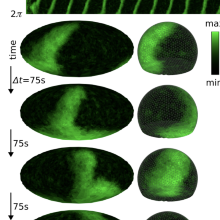S. Erisis and M. Hörning
Biophysical Journal, 2024
doi: 10.1016/j.bpj.2024.03.022
Abstract: ''PIP3 is a signaling lipid on the plasma membrane that plays a fundamental role in cell signaling with a strong impact on cell physiology and diseases. It is responsible for the protruding edge formation, cell polarization, macropinocytosis and other membrane remodeling dynamics in cells. It has been shown that the membrane confinement and curvature affects the wave formation of PIP3 and F-actin. But even in the absence of F-actin, a complex self-organization of the spatiotemporal PIP3 waves is observed. In recent findings, we have shown that these waves can be guided and pinned on strongly bended Dictyostelium membranes caused by molecular crowding and curvature limited diffusion. Based on these experimental findings, we investigate the spatiotemporal PIP3 wave dynamics on realistic 3D cell-like membranes to explore the effect of curvature limited diffusion, as observed experimentally. We use an established stochastic reaction-diffusion model with enzymatic Michaelis-Menten type reactions that mimics the dynamics of Dictyostelium cells. As these cells mimic the 3D shape and size observed experimentally, we found that the PIP3 wave directionality can be explained by a Hopf-like and a reverse periodic-doubling bifurcation for uniform diffusion and curvature limited diffusion properties. Finally, we compare the results with recent experimental findings and discuss the discrepancy between the biological and numerical results.''


